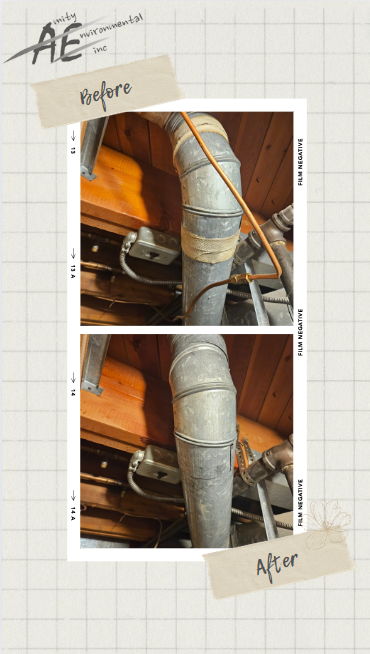Abatement understanding starts here
Asbestos, once celebrated for its durability and heat resistance, is now known as a major health hazard. When asbestos-containing materials (ACMs) are disturbed, they release fibers into the air, which can be inhaled and cause serious diseases like asbestosis, lung cancer, and mesothelioma. That’s why proper asbestos abatement is crucial to keeping everyone safe. Among the different levels of abatement, moderate risk asbestos abatements strike a balance between complexity and safety.
What is Moderate Risk Asbestos Abatement?
Moderate risk asbestos abatements deal with ACMs that aren’t highly friable (easily crumbled) but still pose a risk if disturbed. These tasks are more complex than low-risk abatements but don’t involve the highly hazardous materials that high-risk abatements address.
Identifying Moderate Risk Situations
Moderate risk abatement scenarios typically involve:
- Using non-powered hand tools to cut, shape, drill or remove a non-friable manufactured product containing asbestos if water is not used to control fiber release.
- Using a mechanical or electrically powered tool fitted with a HEPA filter dust collector to cut, shape or grind non-friable manufactured products containing asbestos.
- Removing all or part of a false ceiling to gain access to a work area and where friable asbestos containing materials are, or are likely to be, lying on the surface of the false ceiling.
- Removing, encapsulating, enclosing or disturbing minor areas (less than 0.09 m2 or 1 sq. ft.) of friable asbestos-containing material during the repair, alteration, maintenance, demolition or dismantling of a building, structure, machine, tool or equipment, or parts of it.
- Performing glovebag operations
- Dry buffing and stripping vinyl asbestos tile
- Renovation or hand demolition involving drywall joint compound, block mortar, stucco or brick mortar products containing asbestos.
- Removal of 9.3 m2 (100 sq. ft.) or less of contiguous ceiling tile containing asbestos or sheet vinyl flooring/vinyl floor tiles having an asbestos backing.
- Cutting, breaking, or otherwise damaging non-friable asbestos material during its dry removal.

Key Steps in Moderate Risk Asbestos Abatement
- Assessment and Planning
- Inspection: A certified asbestos inspector assesses the area to identify the presence and condition of ACMs.
- Risk Assessment: Determine the level of risk associated with the abatement and develop a detailed plan outlining procedures, safety measures, and necessary equipment.
- Containment
- Work Area Preparation: Seal off the work area using plastic sheeting and create a negative pressure environment to prevent asbestos fibers from spreading.
- Decontamination Units: Set up decontamination units at entry and exit points so workers can safely remove contaminated clothing and equipment.
- Personal Protective Equipment (PPE)
- Workers wear appropriate PPE, including disposable coveralls, gloves, and respiratory protection (e.g., P100 respirators).
- Ensure that PPE is properly fitted and regularly inspected for damage.
- Safe Removal Techniques
- Wet Methods: Use water to dampen ACMs before removal to minimize dust.
- Minimal Breakage: Handle materials carefully to prevent them from breaking apart and releasing fibers.
- HEPA Vacuums: Use High-Efficiency Particulate Air (HEPA) vacuums to clean up debris and dust.
- Waste Disposal
- Collect and double-bag asbestos waste in labeled, leak-tight containers.
- Transport waste to a designated landfill authorized to accept asbestos-containing materials.
- Air Monitoring
- Conduct air monitoring before, during, and after abatement to ensure that asbestos fiber levels stay within safe limits.
- Use independent, accredited laboratories to analyze air samples for accuracy and compliance.
Training and Certification
Workers involved in moderate risk asbestos abatements go through rigorous training and certification to ensure they understand the hazards and proper abatement techniques. This includes:
- Asbestos Awareness Training: Basic understanding of asbestos and its health effects.
- Asbestos Abatement Worker Training: In-depth training on safe handling, removal, and disposal procedures.
- Supervisor Training: Additional training for those overseeing abatement projects, covering regulatory compliance and emergency response.
Regulatory Compliance
Moderate risk asbestos abatement projects comply with regulations set by agencies like Occupational Health and Safety (OH&S), and relevant local authorities. Compliance ensures the safety of workers and the protection of the environment and the public.
In Conclusion
Moderate risk asbestos abatements require careful planning, appropriate safety measures, and trained professionals to ensure the safe removal of hazardous materials. By following best practices and adhering to regulatory standards, we can mitigate the risks associated with asbestos exposure and protect both workers and the public from its harmful effects.
Understanding the nuances of moderate risk asbestos abatement is crucial for anyone involved in renovation, construction, or maintenance projects where ACMs may be present. Proper execution of these procedures helps maintain a safe environment and promotes public health.
By approaching asbestos abatement with diligence and care, we can manage and mitigate the risks associated with this once-common material, ensuring safer spaces for everyone.
Not sure what kind of risk level your curent abatement is?
Don’t hesitate to contact us today at (403) 667-8264. Amity Environmental can help!
Connect with us!
Instagram:
https://www.instagram.com/amity_environmental
Facebook:
https://www.facebook.com/Amityenvironmental
LinkedIn:
https://www.linkedin.com/company/amityenvironmental/mycompany/?viewAsMember=true
Tik Tok:

